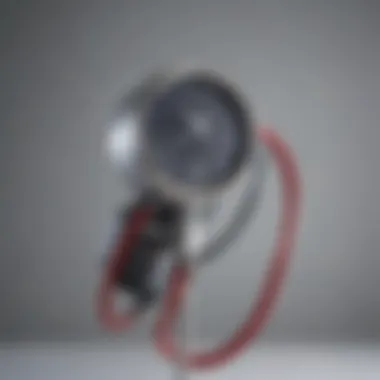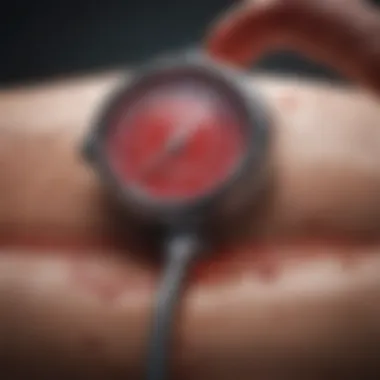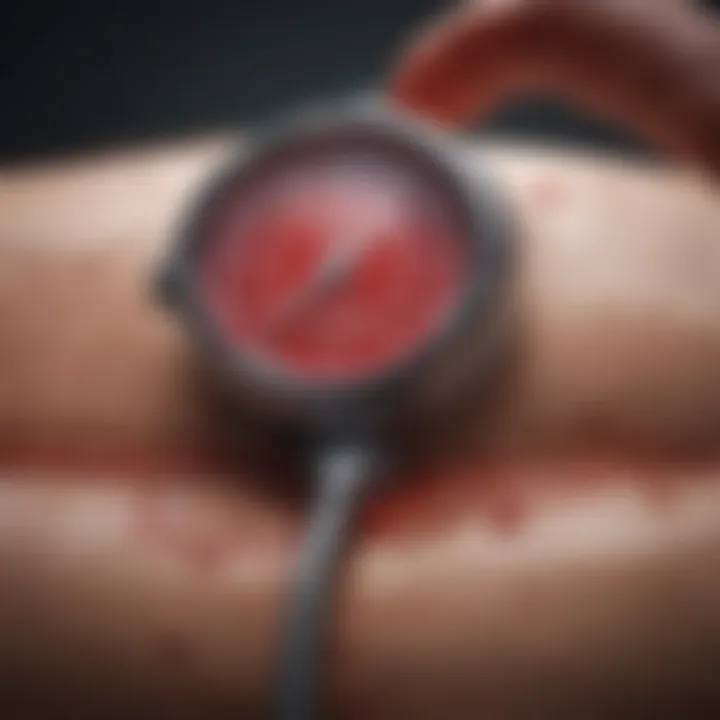Causes and Implications of Orthostatic Hypertension


Research Overview
Orthostatic hypertension is an abnormal spike in blood pressure when a person transitions from sitting or lying down to standing. This phenomenon is increasingly recognized as an important clinical issue, affecting a diverse patient population, from elderly individuals with multiple health concerns to those on specific medications. Understanding the root causes of this condition is crucial for better diagnosis and management, ultimately enhancing patient care.
Summary of Key Findings
Our examination reveals several factors that contribute to orthostatic hypertension, which are categorized into physiological mechanisms, pre-existing health conditions, medications known to affect blood pressure, and lifestyle choices. Significant findings include:
- Physiological Mechanisms: The body's normal response to standing involves a complex interplay between the cardiovascular, nervous, and renal systems. When these responses are impaired, orthostatic hypertension can occur.
- Underlying Conditions: Various health issues, such as diabetes, renal failure, and autonomic dysfunction, have been associated with increased risk of this condition, highlighting the need for a comprehensive assessment in affected patients.
- Medications Impact: Certain drugs, particularly those used to manage other hypertension types, can paradoxically exacerbate orthostatic hypertension.
- Lifestyle Influences: Factors like dehydration, excessive alcohol consumption, and a sedentary lifestyle further complicate blood pressure regulation when transitioning to an upright position.
Relevance to Current Scientific Discussions
The exploration of orthostatic hypertension sheds light on a significant yet often overlooked aspect of cardiovascular health. With rising elderly populations, associated comorbidities, and complex medication regimens, addressing this issue is becoming increasingly relevant in clinical discussions. As researchers delve deeper into the connections between these various aspects, the potential for developing tailored management strategies grows, emphasizing the necessity for further investigation.
Methodology
Research Design and Approach
To accurately assess the causes of orthostatic hypertension, a multi-faceted research design was employed. This involved a combination of literature review, meta-analyses, and clinical studies, providing a thorough understanding of the condition's complexities.
Data Collection and Analysis Techniques
Data were collected from peer-reviewed journals, with a focus on studies that explore the physiological aspects, associated medical conditions, and impacts of treatment regimens. Analysis techniques included:
- Quantitative Analysis: To evaluate the prevalence and incidence rates of orthostatic hypertension in various patient populations.
- Qualitative Analysis: To understand patients' experiences and subjective interpretations of their symptoms through surveys and interviews.
This blend of methodologies offers a comprehensive picture of the factors at play in orthostatic hypertension, ensuring that practitioners have reliable information for effective patient care.
Defining Orthostatic Hypertension
Orthostatic hypertension refers to a sudden and abnormal increase in blood pressure upon standing, which could signal a troubling response of the cardiovascular system. Understanding this condition is not merely an academic exercise; it has profound implications for patient management. By defining orthostatic hypertension thoroughly, healthcare practitioners can establish a solid foundation for assessing patient symptoms, crafting treatment plans, and conducting further research. Whether it’s in evaluating symptoms or strategizing clinical interventions, these definitions help clinicians identify the distinct characteristics of this condition, guiding them in their quest for effective patient care.
Overview of Orthostatic Hypertension
Simply put, orthostatic hypertension occurs when an individual experiences a marked increase in blood pressure after moving from a sitting or lying position to standing upright. This condition can lead to symptoms such as dizziness, palpitations, or even fainting, which makes understanding it imperative.
To illustrate, imagine a person transitioning from bed to standing too quickly; they might feel a brief, dizzy spell, which is a classic response of the body’s blood circulation. However, if their blood pressure spike is excessive, this might indicate an underlying issue that necessitates further scrutiny. In this light, it’s essential to realize that the body operates through various systems to regulate blood pressure, and any disruption might affect everyday activities for affected individuals.
Distinction from Other Blood Pressure Disorders
Orthostatic hypertension often gets lumped together with other blood pressure disorders, leading to confusion. Unlike essential hypertension, which is characterized by a consistently high blood pressure regardless of posture, orthostatic hypertension specifically relates to postural changes.
Additionally, it's important to differentiate between orthostatic hypertension and orthostatic hypotension, the latter representing a drop in blood pressure upon standing. The distinction is crucial; understanding these differences enables clinicians to tailor appropriate treatment, as the interventions for each can vary significantly.
"Recognizing the underlying causes of orthostatic hypertension is as vital as distinguishing it from related conditions."
For those navigating cardiovascular challenges, clarity mitigates risks and supports tailored healthcare solutions.
Physiological Mechanisms
Understanding the physiological mechanisms behind orthostatic hypertension is crucial for comprehending how the body manages blood pressure during daily activities. This article digs into the nuanced ways our body's systems collaborate to regulate blood pressure, especially when transitioning from sitting to standing. A better grasp of these mechanisms not only aids in recognizing the factors influencing this condition but also informs the development of targeted interventions and therapies.
Autonomic Nervous System Functionality
The autonomic nervous system (ANS) plays a vital role in managing blood pressure. It contains two primary branches: sympathetic and parasympathetic. The sympathetic branch is often seen as the body's "fight or flight" response, increasing heart rate and constricting blood vessels to raise blood pressure when required. In contrast, the parasympathetic branch promotes a relaxed state, lowering heart rate and blood pressure.
When a person stands up, the body relies heavily on this intricate balance. If the sympathetic response is insufficient, blood pressure may dip momentarily, causing dizziness or lightheadedness—classic symptoms of orthostatic hypotension. However, in cases of orthostatic hypertension, this balance is disturbed, leading to an abnormal spike in blood pressure upon standing.
It’s essential to recognize that any disruption in the ANS functionality, whether due to stress, chronic illness, or aging, can lead to issues in blood pressure regulation. This complexity underscores the need for ongoing research into how we can restore that delicate balance for individuals experiencing these high-pressure spikes.
Baroreceptor Responses
Baroreceptors serve as the body’s sensors, constantly monitoring blood pressure and sending out alerts when changes occur. Located primarily in the carotid arteries and the aorta, these receptors help to ensure that blood pressure remains stable despite changes in posture, activity level, and temperature.
When a person stands, gravity pulls blood down into the lower extremities, causing a sudden reduction in blood volume returning to the heart. Baroreceptors immediately sense this drop and trigger reflex responses to counterbalance it. Normally, their prompt action leads to increased heart rate and arterial constriction, raising blood pressure back to its baseline.
However, in individuals with orthostatic hypertension, baroreceptor responses can go awry, leading to excessive stimulation of these receptors. The responses may become overly aggressive, causing a degree of hypertension that can precipitate severe complications, like cardiovascular disease.
Vascular Compliance and Resistance


Vascular compliance refers to the ability of blood vessels, especially veins, to expand and accommodate changes in blood volume. Veins should ideally be compliant enough to store blood when necessary and release it upon demand. Conversely, vascular resistance is the opposition faced by blood flow in the circulatory system.
In individuals suffering from orthostatic hypertension, a decrease in vascular compliance can enhance resistance, meaning the blood vessels do not dilate as they should. This stiffer response can heighten blood pressure during standing or exertion.
The interplay between compliance and resistance is intricate. For instance, stiff blood vessels can lead to increased systolic blood pressure, while lower compliance can cause an inadequate blood flow to organs, which could spur further complications.
Understanding these physiological mechanisms is essential for clinicians assessing orthostatic hypertension, allowing them to design personalized management strategies that consider the complexities within each patient’s circulatory system.
In summary, these physiological factors are all interconnected, with the autonomic nervous system, baroreceptor function, and vascular characteristics dancing in tandem to regulate blood pressure. Addressing issues in any of these mechanisms could unveil new avenues for treatment, offering hope for patients navigating the challenges of orthostatic hypertension.
Underlying Health Conditions
Understanding the underlying health conditions associated with orthostatic hypertension is crucial for both diagnosis and management. These conditions can either be primary causes or secondary influences, impacting how the body responds to changes in posture. Without recognizing these underlying ailments, healthcare professionals might struggle to address the true nature of the patient's condition effectively.
The interplay between orthostatic hypertension and various health issues raises many considerations. Patients suffering from cardiovascular diseases, diabetes, endocrine disorders, and neurological conditions may express a heightened sensitivity to the changes in blood pressure that occur upon standing. Understanding these connections helps clinicians refine their approaches to managing each individual patient and avoid pitfalls that might arise from a one-size-fits-all strategy.
"Addressing the root of orthostatic hypertension often requires a broad view of a patient's overall health, as contributions can stem from multiple sources."
Cardiovascular Diseases
Cardiovascular diseases are often linked with fluctuations in blood pressure and may exacerbate the symptoms of orthostatic hypertension. Conditions such as heart failure, coronary artery disease, and arrhythmias affect how effectively the heart pumps blood. When a patient with these issues stands up, they may experience a rapid rise in blood pressure, leading to complications like dizziness or fainting.
Specific mechanisms, like decreased cardiac output and impaired vascular responses, play a role here. For instance, in heart failure, the heart struggles to maintain adequate blood flow, and changing position can reveal and intensify the body's limitations. Managing these conditions is vital, as not only does it help control orthostatic hypertension, but it also improves overall cardiovascular health and quality of life for the patient.
Diabetes and Its Complications
Diabetes presents a uniquely complex challenge for individuals dealing with orthostatic hypertension. The complications arising from diabetes, such as neuropathy and autonomic dysfunction, can impair the body's ability to respond appropriately to postural changes. This dysfunction affects blood vessel reflexes, leading to abnormal increases in blood pressure when standing.
For example, diabetic autonomic neuropathy disrupts the parasympathetic nervous system, which typically helps moderate heart rate and blood vessel dilation. In such cases, patients might require a tailored management plan focusing on glycemic control and potential medications that better stabilize blood pressure.
Endocrine Disorders
Endocrine disorders, like Addison's disease or hyperaldosteronism, also factor significantly into the equation. These conditions may lead to dysregulation of hormones that are pivotal in maintaining blood pressure and fluid balance. For instance, hyperaldosteronism results in elevated sodium retention and can cause elevated blood pressure, affecting the body's ability to handle changes in posture effectively.
Awareness of how these endocrine issues interplay with orthostatic discrepancies is key for practitioners. Effective treatment plans could hinge on correcting hormonal imbalances while monitoring for potential orthostatic responses.
Neurological Conditions
Lastly, neurological conditions such as Parkinson's disease or multiple sclerosis can contribute significantly to the challenges of orthostatic hypertension. These conditions often lead to autonomic dysfunction, specifically affecting the body's ability to regulate blood pressure changes when moving from sitting to standing.
The role of the autonomic nervous system is crucial here. Disruption in communication pathways means that the body may not react swiftly enough to stabilize blood pressure during postural changes. It’s essential for healthcare providers to be vigilant about these conditions, ensuring that any orthostatic issues are managed in conjunction with neurological assessments.
Medications and Their Effects
Understanding how medications impact orthostatic hypertension is crucial. This condition can be exacerbated or mitigated depending on the drugs a patient is taking. It's a tightrope walk; careful management is essential to avoid unwarranted spikes in blood pressure upon standing. Each category of medication possesses its own set of benefits and considerations that must be weighed in the clinical decision-making process.
Antihypertensive Drugs
Antihypertensive medications are designed to lower blood pressure, thus countering hypertension. However, some of these drugs can lead to orthostatic hypotension, potentially making orthostatic hypertension worse. Beta-blockers like metoprolol can sometimes cause a reduced heart rate, impacting how blood pressure responds during position changes. Other medications, like ACE inhibitors, might cause blood vessels to relax, yet in some cases, this can lead to sudden drops in blood pressure when a person stands up, reflecting the complex interplay between these treatments and patient physiology.
The practitioner has to balance treating high blood pressure while being cognizant of the risks associated with movement. They must monitor patients closely, ensuring that any increase in standing-induced blood pressure is managed proactively. If a patient reports dizziness or fainting when standing, adjustments to these antihypertensive regimens might be necessary.
Diuretics
Diuretics, commonly prescribed to manage fluid retention and high blood pressure, may have a paradoxical effect in patients with orthostatic hypertension. While they reduce blood volume and overall blood pressure, what's often overlooked is that they can also lead to dehydration and electrolyte imbalances. This can worsen symptoms like dizziness when standing.
Patients using diuretics should be monitored carefully for changes in cognitive function and overall mobility. A sudden drop in blood pressure upon standing after diuretic usage can lead to adverse situations, particularly in the elderly or those with existing health problems. Dietary adjustments to include potassium-rich foods or specific electrolyte supplements can sometimes help in this context.
Psychotropic Medications
Psychotropic medications, widely used for mental health disorders, often have side effects that influence blood pressure regulation. Antidepressants, particularly tricyclics like amitriptyline, are notorious for inducing orthostatic hypotension. The sedation and anti-cholinergic effects can lead to blood pressure changes when moving from sitting to standing.
Furthermore, medications that target anxiety, like benzodiazepines, can affect muscle tone and possibly lead to a fall in blood pressure as one stands. It’s again about finding that balance. Patients using these medications should be educated on potential symptoms of orthostatic intolerance—sudden dizziness, light-headedness, or even fainting. Posture training, gradual position changes, and hydration can be effective strategies in managing these side effects.
The interplay between medications and orthostatic hypertension is multidimensional. Physicians must holistically consider patient history, current medications, and their effects on blood pressure when determining a comprehensive management plan.
In summary, the role of medications in orthostatic hypertension cannot be understated. The nuanced effects require practitioners to prioritize personalized approaches for their patients, ensuring rigorous monitoring and tailored treatment plans.
Lifestyle Factors
Lifestyle choices play a pivotal role in the manifestation and management of orthostatic hypertension. By examining these factors, we can uncover how daily habits impact this condition and influence overall health. When it comes to managing blood pressure, understanding lifestyle factors is not merely a matter of anecdotal evidence; it forms the cornerstone of a comprehensive approach to treatment and care.


Dietary Influences
The food we consume can significantly sway blood pressure levels. Diets rich in sodium, for instance, are often linked to elevated blood pressure, leading to possible exacerbation of orthostatic hypertension. On the flip side, foods high in potassium can help regulate and lower blood pressure. Fruits and vegetables — bananas, spinach, and avocados, for example — are packed with potassium and can be instrumental in creating a balanced diet.
Additionally, a diet that includes adequate amounts of fiber typically promotes cardiovascular health. Whole grains, legumes, seeds, and nuts are not only nutritious but also help in maintaining a healthy weight which is crucial for blood pressure regulation.
Many experts advocate the Mediterranean diet, known for its beneficial cardiovascular effects due to healthy fats from olive oil and omega-3s from fish. Thus, when discussing dietary influences, it’s clear that what’s on the plate matters.
Physical Activity Levels
Regular exercise is an unsung hero in the management of orthostatic hypertension. Physical activity does not only serve to strengthen the cardiovascular system but also contributes to better regulation of blood pressure. A well-rounded routine that includes aerobic exercises, strength training, and flexibility workouts can yield profound effects on how the body responds to changes in position.
Conversely, leading a sedentary lifestyle may contribute to poor vascular health. Research shows that even simple activities such as walking, cycling, or gardening can help keep blood pressure at bay. Therefore, it is essential to promote an active lifestyle and encourage movement throughout the day.
Fluid Intake Patterns
Hydration is an element that often gets glossed over, yet it plays a crucial role in cardiovascular health. Adequate fluid intake helps maintain blood volume, which is critical for preventing drastic changes in blood pressure when transitioning from sitting to standing.
Consumers should pay attention to their individual hydration needs, as these can vary based on factors such as climate, activity level, and overall health. For instance, elderly individuals may require more water to counteract the natural decline in thirst sensation.
Moreover, caffeine and alcohol can impact blood pressure in varying ways; moderation in consumption can therefore be a useful approach. In contrast, increasing water intake can lead to improvements in blood volume, potentially alleviating symptoms of orthostatic hypertension.
Essentially, lifestyle factors, including diet, physical activity, and hydration, can significantly influence the management of orthostatic hypertension and overall cardiovascular health.
In summary, awareness and adjustments in lifestyle are vital components that can make a profound difference. More than just personal choice, they can lead to better outcomes for individuals grappling with orthostatic hypertension.
Age-Related Considerations
Understanding the role that age plays in orthostatic hypertension is crucial for both patient care and research. As individuals age, there are significant changes in the body's physiological responses, particularly concerning blood pressure regulation. These age-related factors lead to variations in how blood pressure responds upon standing, warranting a closer look at two primary angles: the impact of aging on blood pressure regulation and the gender differences observed in older adults.
Impact of Aging on Blood Pressure Regulation
Aging brings with it a plethora of physiological changes that have direct implications for blood pressure management. One of the most significant changes occurs in the cardiovascular system, which may show reduced vascular compliance. As arteries become stiff over time, their ability to accommodate the sudden influx of blood when an individual stands diminishes. Consequently, this lack of adaptability can lead to increased blood pressure in older adults upon standing.
Additionally, the autonomic nervous system, responsible for regulating blood pressure in response to postural changes, may also become less effective with age. The baroreceptors, which act as sensors for blood pressure changes, may not respond as swiftly or effectively. This dysfunctional response can lead to a greater incidence of orthostatic hypertension in older populations.
Key points to consider include:
- Vascular changes: Arterial stiffness increases with age, affecting blood flow regulation.
- Nervous system response: A slower response mechanism can contribute to blood pressure instability.
To elucidate the significance of these changes, it's important to examine the statistics. Studies indicate that a substantial proportion of adults aged 65 and older experience some form of orthostatic dysregulation, making it vital for practitioners to understand these underlying mechanisms when assessing older patients.
"Aging isn't solely about counting years; it’s deeply tied to how our bodies manage essential functions like blood pressure."
Gender Differences in Older Adults
Gender differences play a pivotal role in understanding how older adults experience orthostatic hypertension. Research reveals that older men and women might exhibit differing patterns of blood pressure regulation. Generally, men tend to experience more cardiovascular issues earlier in life, which also impacts their blood pressure regulation as they age. In contrast, women, particularly post-menopausal women, face their own unique challenges, primarily attributed to hormonal changes that affect vascular health.
For instance:
- Men: Often present with higher rates of hypertension earlier, and they may face starker declines in vascular compliance as they age.
- Women: Post-menopause, there's a marked decline in estrogen, which can negatively impact vascular function and contribute to fluctuations in blood pressure.
This divergence between genders highlights the necessity for tailored approaches in treating and managing orthostatic hypertension in older populations. Clinicians must remain cognizant of these gender-specific factors, as they can influence diagnosis and treatment outcomes.
Ultimately, addressing age-related considerations in orthostatic hypertension equips healthcare providers with the insights necessary to cater to their patients' unique profiles and needs.
Evaluating Orthostatic Hypertension
Evaluating orthostatic hypertension is crucial, as it provides essential insights into the health challenges many patients face, particularly when changing positions. This condition poses a significant risk, affecting not just blood pressure, but also the patients' overall well-being and quality of life. Understanding how to properly evaluate this condition can lead to earlier detection and more effective management strategies, ultimately making a considerable difference in a person's health trajectory.
Diagnostic Criteria
The diagnostic criteria for orthostatic hypertension focus on the measurements and observations made during a standard clinical evaluation. To assess whether a patient falls into the category of having this condition, the following criteria are typically considered:
- Blood Pressure Measurement: A sitting or supine blood pressure reading is taken, followed by a measurement after standing for a specified duration, typically between 1 and 3 minutes.
- Threshold Values: An increase in systolic blood pressure of more than 20 mm Hg or diastolic blood pressure more than 10 mm Hg upon standing is generally indicative of orthostatic hypertension.
- Symptoms Evaluation: Besides the objective measurements, subjective symptoms such as dizziness, lightheadedness, or fainting that accompany the changes in blood pressure are significant in the diagnosis.
"In diagnosing orthostatic hypertension, the interplay between objective measurements and subjective symptoms creates a more complete picture, helping guide treatment decisions effectively."
The importance of adhering to these criteria cannot be overstated. Incorrect evaluations might lead to misdiagnoses, which could in turn result in inappropriate management strategies that may exacerbate patient malaise.
Testing Procedures and Protocols


Proper testing procedures and protocols are fundamental for accurate diagnosis and management of orthostatic hypertension. The following steps outline a standardized approach:
- Pre-Examination Preparation: Before undertaking any measurements, it’s pivotal to ensure that the patient is at rest and has refrained from caffeine or alcohol consumption, as these can influence blood pressure.
- Initial Blood Pressure Reading: Begin with taking a seated blood pressure reading after the patient has been at rest for at least 5 minutes. This establishes a baseline measurement.
- Standing Measurement: After the baseline reading is recorded, the patient should be instructed to stand up. Blood pressure readings should then be taken immediately after standing and at intervals, such as the 1-minute and 3-minute marks from the standing position.
- Symptom Documentation: During this process, note any symptoms the patient may experience as they change positions. This qualitative data is just as important as quantitative readings.
- Data Analysis: Once data is collected, it is important to analyze both the changes in blood pressure and any symptoms reported to identify patterns characteristic of orthostatic hypertension.
By following these procedures meticulously, clinicians can ascertain a comprehensive view of the patient's blood pressure behavior across different positions. This thorough evaluation leads to a nuanced understanding of how orthostatic hypertension manifests in each individual, thereby informing effective treatment plans.
Management Strategies
In the realm of orthostatic hypertension, devising effective management strategies is crucial. Understanding how to mitigate the impact of this condition not only enhances patient well-being but also empowers healthcare professionals to tailor solutions to individual needs. The management of orthostatic hypertension encompasses various dimensions, from pharmacological interventions to lifestyle modifications. Each element plays a vital role in controlling symptoms and improving patient outcomes.
Medications and Treatment Options
Medications are often the frontline defense against the challenges posed by orthostatic hypertension. A tailored approach is essential as patients may respond differently to various drugs. Here are some commonly prescribed treatment options:
- Fludrocortisone: This is a synthetic mineralocorticoid that helps the body retain sodium, effectively increasing blood volume and blood pressure while addressing orthostatic symptoms.
- Midodrine: Often used for its vasopressor effects, midodrine acts by constricting blood vessels, helping to manage blood pressure more effectively when standing.
- Droxidopa: This medication, primarily aimed at neurogenic orthostatic hypotension, converts to norepinephrine to enhance vascular tone, thus playing a role in increasing blood pressure.
Successful management requires a comprehensive understanding of the patient's health profile. The prescriber must consider potential drug interactions and contraindications, and regular follow-up is necessary to adjust dosages or even consider alternative therapies. It’s also valuable to educate patients on the importance of adhering to their medication regimen to ensure optimal results.
Therapeutic Lifestyle Changes
Beyond medications, therapeutic lifestyle changes stand out as an essential avenue for managing orthostatic hypertension. Patients are encouraged to make small, yet impactful adjustments in their daily routines. Here are several strategies:
- Gradual Position Changes: Encourage patients to rise slowly from sitting or lying positions. This simple practice can help prevent the sudden drop in blood pressure.
- Increased Fluid Intake: Staying well-hydrated is fundamental. Drinking more fluids can improve blood volume and thus help stabilize blood pressure levels.
- Salt Intake: While it's essential to consult a healthcare professional, increasing dietary salt can help boost blood volume, which may be advantageous for some individuals with orthostatic hypertension.
- Regular Exercise: Physical activity, especially resistance training, can foster better cardiovascular health and improve the body's ability to regulate blood pressure.
"Lifestyle changes not only empower patients but also create a holistic approach to managing orthostatic hypertension."
- Compression Garments: Wearing compression stockings can help minimize blood pooling in the lower extremities, promoting better circulation.
In sum, embracing these therapeutic lifestyle changes can lead to improved quality of life for patients suffering from orthostatic hypertension. Coordination between healthcare providers and patients remains crucial in implementing these strategies effectively.
Research and Future Directions
Research into orthostatic hypertension is not just about understanding symptoms and diagnosis; it encompasses a broader spectrum of insights that can influence patient outcomes. Investigating this medical condition can open new avenues in understanding not only the mechanisms that lead to its development but also its intertwined relationship with other comorbid conditions. With the increasing prevalence of chronic diseases and an aging population, delving into this area stands as a pathway to improved public health outcomes.
Focusing on research trends allows healthcare professionals to identify strategies and interventions that can effectively mitigate the condition. The findings not only bear implications for patients but also inform clinical practices, guiding health practitioners in creating comprehensive care plans. Furthermore, as technology advances, so does the opportunity to employ innovative approaches in managing orthostatic hypertension.
Current Research Trends
Several recent research studies have illuminated the complexities surrounding orthostatic hypertension. One notable trend is the exploration of its connections with various health conditions, particularly cardiovascular diseases. Researchers are examining how hypertension’s interplay with heart failure, diabetes, and renal dysfunction can exacerbate patient outcomes.
Promising areas include:
- Genetic Factors: Recent studies have sought to identify specific genetic markers that might predispose individuals to orthostatic hypertension.
- Heart Rate Variability: Investigations have aimed at understanding the role of heart rate variability as a potential indicator of autonomic nervous system health in relation to blood pressure changes.
- Diet and Nutrition: Some researchers are studying how different dietary patterns impact blood pressure, emphasizing the role of sodium, potassium, and hydration levels.
These research trends not only reveal critical insights related to the condition, but they also contribute to a better understanding of broader cardiovascular health considerations.
Potential New Treatments
Looking ahead, the landscape of potential treatments for orthostatic hypertension is expanding, thanks to ongoing research. Innovative methods focus on both pharmacological and non-pharmacological strategies aimed at alleviating symptoms and enhancing quality of life.
Among the promising avenues:
- Digital Health Solutions: Wearable technology that monitors cardiovascular parameters offers real-time data, potentially alerting patients to orthostatic changes before symptoms ensue.
- Targeted Pharmacotherapy: New drugs that focus on vascular homeostasis are under examination, presenting hope for unique treatment options tailored to individual patient profiles.
- Behavioral Therapies: Interventions focusing on lifestyle changes—such as tailored exercise programs—are gaining traction as effective adjuncts to conventional treatment methods.
Continued research into these areas not only seeks to provide relief to patients but also nudges the healthcare community toward more comprehensive and integrated care approaches. Understanding the nuances of orthostatic hypertension through the lens of current trends will lead to better management strategies that are responsive to patient needs.
"The art of medicine consists in amusing the patient while nature cures the disease." - Voltaire
As the pursuit of knowledge continues in the realm of orthostatic hypertension, it stands as a reminder of the importance of maintaining curiosity and commitment to improving health outcomes.
The End
In summary, understanding orthostatic hypertension is vital not only for healthcare professionals but also for patients who seek clarity about their condition. This article delved into various aspects of orthostatic hypertension, shedding light on its physiological mechanisms, health-related causes, and management strategies.
Summarizing the Key Points
- Definition and Distinction: We began by defining orthostatic hypertension and distinguishing it from other blood pressure disorders. Knowing what sets this condition apart helps in better identification and management.
- Physiological Mechanisms: The physiological underpinnings were explored in detail, including the autonomic nervous system's role and the functionality of baroreceptors. These mechanisms are crucial for regulating blood pressure during changes in posture.
- Health Conditions: Underlying health issues such as cardiovascular diseases, diabetes, and neurological disorders were examined as key contributors to the emergence of orthostatic hypertension. Each condition offers unique challenges and considerations.
- Medication Impact: Various medications, particularly antihypertensives and psychotropic drugs, can exacerbate symptoms. Awareness of these effects is essential for both practitioners and patients.
- Lifestyle Factors: We also discussed how dietary choices, levels of physical activity, and fluid intake can play significant roles in managing the condition.
- Future Directions: With ongoing research, new treatment pathways are arising that could transform how this condition is approached, offering hope for patients who struggle with it.
Overall, this comprehensive overview serves not just as a guide for understanding orthostatic hypertension, but also as a foundation for effective management strategies.
Implications for Clinical Practice
The need for a nuanced understanding of orthostatic hypertension cannot be overstated. Clinicians must adopt a multifaceted approach when addressing this condition in their patients. Here are some considerations:
- Individualized Assessment: Each patient presents a unique profile influenced by various factors including age, lifestyle, and underlying health problems. An individualized assessment is important in determining the most effective management plan.
- Monitoring and Follow-Up: Regular monitoring of blood pressure changes, particularly postural changes, can assist in capturing the nuances of a patient’s condition timely.
- Patient Education: Empowering patients through education on lifestyle adjustments, medication management, and self-monitoring can significantly impact health outcomes.
- Interdisciplinary Collaboration: Collaboration among healthcare providers—general practitioners, cardiologists, endocrinologists, and dietitians—can lead to more comprehensive care tailored to a patient's unique needs.
Addressing orthostatic hypertension effectively can minimize complications and enhance patients’ quality of life. A well-rounded approach could pave the way for better therapeutic outcomes, aligning patient needs with practical interventions.



